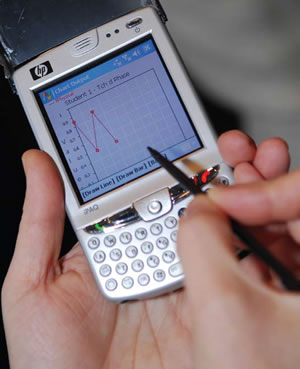Improving the Lives of Those with Disabilities
May 3, 2010
For a young person with a disability, keeping up with other students in the classroom can be frustrating and overwhelming. Michael Behrmann, professor of special education and director of the Helen A. Kellar Institute for Human disAbilities, has devoted his career to finding ways to aid these children and their teachers. As a result, Mason is home to one of the oldest assistive technology training programs in the country.

Michael Behrmann
The use of assistive technology enables children with severe learning and other disabilities to perform tasks they were unable to accomplish or had great difficulty with by providing them alternative ways to complete these tasks.
Behrmann, who is entering his 29th year at Mason, began his research in assistive technology in special education in 1981. His interest in technology integration has led him to receive numerous grants for training, technical assistance, and research. Part of the College of Education and Human Development, the Kellar Institute combines Mason resources with those of local, state, and national public- and private-sector agencies to develop products, services, and programs.
One such program is the Accessible Instructional Materials (AIM) Virginia Project, which provides free accessible instructional materials to Virginia public schools. While the National Instructional Materials Accessibility Standard established by the federal government requires that all children with print disabilities have access to instructional materials, the Commonwealth of Virginia has broadened this initiative to establish its own system for providing these materials to the estimated 70,000 children in Virginia with print disabilities.
AIM Virginia operates as a library, loaning electronic copies of textbooks and supplemental materials to eligible children in public schools for free. Going beyond federal requirements, AIM Virginia also supplies electronic copies of other books or materials students may need. For example, if a teacher needs an electronic copy of The Red Badge of Courage, he or she supplies AIM with a print copy of the book, which is then scanned and turned into Braille, large-print, or any other format needed. A state-of-the-art scanner, capable of scanning up to 2,400 pages per hour, is housed at Mason and used by Behrmann and his team to produce these materials.
The Kellar Institute was selected for the AIM Virginia headquarters because Mason has provided similar services to the university for many years (although in a much lower volume and with a limited range of materials), has a collaborative relationship with the Virginia Department of Education, and has the faculty, staff, and students who can work on this project.
Another of Behrmann's projects is the Kellar Instructional Handheld Data (KIHD) System, which allows teachers to collect data on observable student behavior more accurately and conveniently. The system can be used to observe children with any disability and is compatible with any browser-based device such as a computer, BlackBerry, or cell phone.
Currently, teachers who want to observe student behavior to track their progress often must rely on their memories or take time to chart the data with paper and pencil. With the KIHD System, teachers can observe students and simultaneously input data into whatever browserbased device they choose, eliminating the problem of teachers forgetting what they have observed or from spending hours at the end of the day entering data from handwritten notes. The data collected on KIHD Systems are automatically graphed for further analysis.
"The KIHD System will give teachers more time in the classroom for instruction, rather than using that time to record and graph the data they've collected," says Behrmann. "I've been able to teach techniques, such as applied behavioral analysis for classroom management, but now teachers have a device for collecting and graphing data in real time."

"The KIHD System will give teachers more time in the classroom for instruction, rather than using that time to record and graph the data they've collected."
The KIHD System may also play a major role in the development of the Response to Intervention (RTI) method, a program instituted by the U.S. Department of Education. RTI assists children who are having difficulty learning, as well as diagnoses learning disabilities. A three-tiered approach, RTI uses an intervention method to test children who are not performing at the same rate as others.
For example, to determine the time a child needs to develop his or her reading skills, a teacher would give the child an extra 30 minutes three times a week. If the child did not improve after the intervention, the teacher would move to tier two and give the child an extra 45 minutes, five times a week. An obstacle facing RTI is that there is no effective way to tell whether the interventions are working.
By charting the child's progress using the KIHD System, teachers can determine whether educational or behavioral interventions are effective or need to be increased or decreased. Children who do not respond to interventions are considered to have disabilities and in need of special education. Using the KIHD System can also help teachers make sure their students meet the testing standards set by the commonwealth.
The KIHD System also has many uses outside the classroom. Zookeepers who track animal behavior or industrial psychologists who study assembly line behavior can benefit from the device, as well as others who measure observable behavior.
In 2007, Behrmann and the university were recognized by the Arc of Northern Virginia, an organization that advocates on behalf of Virginians with disabilities and their families, for "working to create an infrastructure that truly allows students to work, learn, and compete side-by-side with their peers without disabilities."
—Catherine Ferraro
